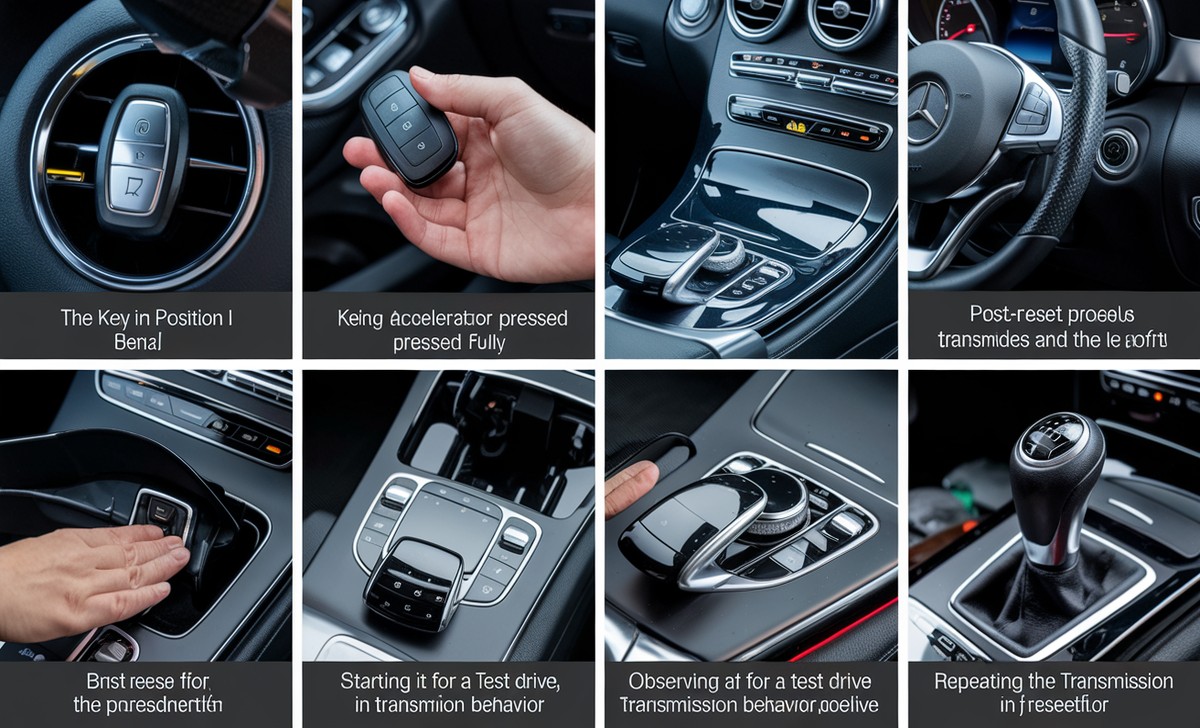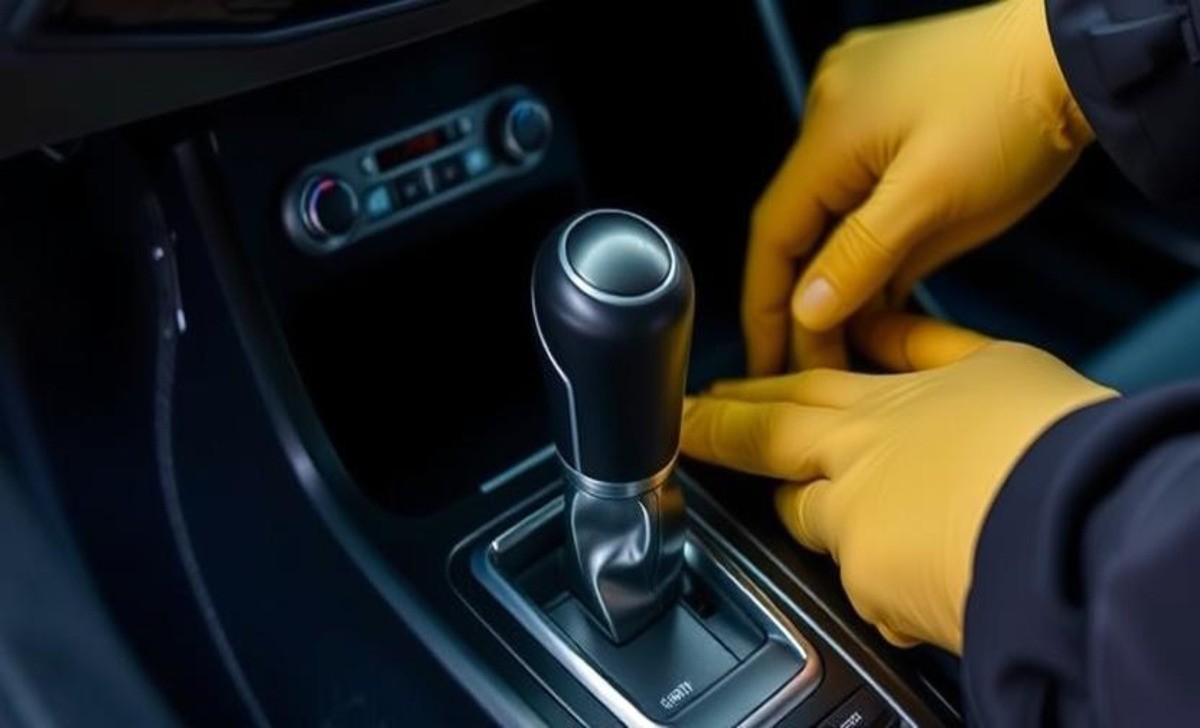Is your Mercedes-Benz experiencing rough shifting or transmission issues? A Mercedes Transmission Reset can often resolve these problems by recalibrating the transmission control module (TCM). At CAR-TOOL.EDU.VN, we’ll guide you through the process, helping you restore smooth shifting and optimize your vehicle’s performance. Learn about common symptoms, step-by-step reset procedures, and when to seek professional assistance for your Mercedes-Benz automatic transmission.
Contents
- 1. Understanding the Mercedes Transmission Reset
- 1.1. What is the Transmission Control Module (TCM)?
- 1.2. Why Might You Need a Transmission Reset?
- 1.3. Benefits of Performing a Transmission Reset
- 2. Identifying the Symptoms: When to Consider a Reset
- 2.1. Common Symptoms Indicating a Need for Reset
- 2.2. Understanding Transmission Error Messages
- 2.3. Differentiating Between Minor and Major Transmission Issues
- 3. Preparing for the Mercedes Transmission Reset Procedure
- 3.1. Gathering Necessary Tools and Equipment
- 3.2. Safety Precautions to Keep in Mind
- 3.3. Ensuring the Vehicle is in the Correct State
- 4. Step-by-Step Guide to Resetting Your Mercedes Transmission
- 4.1. The Accelerator Pedal Reset Method
- 4.2. Alternative Reset Methods (If Applicable)
- 4.3. Common Mistakes to Avoid During the Reset
- 5. Post-Reset Procedures: Ensuring a Successful Reset
- 5.1. Starting the Vehicle and Initial Observations
- 5.2. Taking the Vehicle for a Test Drive
- 5.3. Interpreting Changes in Transmission Behavior
- 6. When to Seek Professional Help: Recognizing Complex Issues
- 6.1. Identifying Persistent or Recurring Transmission Problems
- 6.2. Understanding the Limits of a DIY Transmission Reset
- 6.3. Finding a Qualified Mercedes-Benz Technician
- 7. Preventative Maintenance Tips for Transmission Health
- 7.1. Regular Transmission Fluid Checks and Changes
- 7.2. Monitoring the Torque Converter and its Function
- 7.3. Adhering to Scheduled Maintenance
- 8. Conclusion: Maintaining Optimal Transmission Performance
- 9. Frequently Asked Questions (FAQs)
- 9.1. What are the benefits of resetting my Mercedes-Benz transmission?
- 9.2. How often should I reset my transmission?
- 9.3. Can resetting the transmission fix all gear-shifting issues?
- 9.4. Is it safe to reset the transmission myself, or should I always go to a professional?
- 9.5. What should I do if the transmission reset does not resolve the issue?
- 9.6. Will resetting the transmission affect other vehicle systems?
- 9.7. Can a transmission reset improve my car’s overall performance?
- 9.8. How do you reset the transmission on a Mercedes-Benz vehicle?
- 9.9. How do I reset my transmission settings on a Mercedes-Benz?
- 9.10. What should I do if resetting the transmission doesn’t fix the problem?
1. Understanding the Mercedes Transmission Reset
A Mercedes transmission reset involves recalibrating the vehicle’s transmission control module (TCM). This process can resolve minor shifting issues, improve overall transmission performance, and adapt the transmission’s behavior to your driving style. According to a study by the Society of Automotive Engineers (SAE), recalibrating the TCM can improve shift quality by up to 20% in some cases.
1.1. What is the Transmission Control Module (TCM)?
The Transmission Control Module (TCM) is a critical component of your Mercedes-Benz’s automatic transmission system. It’s essentially a computer that monitors various sensors and controls the shifting of gears. The TCM uses complex algorithms to determine the optimal shift points based on factors like:
- Vehicle Speed: How fast the car is traveling.
- Throttle Position: How much the driver is pressing the accelerator pedal.
- Engine Load: How hard the engine is working.
- Driving Mode: Whether the car is in Comfort, Sport, or another mode.
By analyzing these inputs, the TCM tells the transmission when to shift gears for optimal performance, fuel efficiency, and driver comfort. Over time, the TCM “learns” your driving habits and adapts its shift patterns accordingly. However, this learning process can sometimes lead to issues like harsh shifting or delayed gear changes, making a reset necessary.
 Mercedes Transmission Control Module
Mercedes Transmission Control Module
1.2. Why Might You Need a Transmission Reset?
Several factors can necessitate a Mercedes transmission reset. These include:
- Rough or Jerky Shifting: The transmission shifts gears abruptly or with a noticeable jolt.
- Delayed Shifting: A noticeable pause between when you expect the car to shift and when it actually does.
- Incorrect Gear Selection: The transmission selects the wrong gear for the driving conditions.
- Transmission Slippage: The engine revs up without a corresponding increase in speed.
- Error Messages: A transmission-related error message appears on the dashboard.
- After Transmission Service: Performing a reset after transmission fluid changes or repairs can ensure optimal performance.
According to Mercedes-Benz service bulletins, resetting the transmission can also help resolve issues related to adaptive learning, where the transmission’s shift patterns become skewed over time due to changing driving conditions or driver habits.
1.3. Benefits of Performing a Transmission Reset
Resetting your Mercedes-Benz transmission can provide several benefits:
- Smoother Shifting: Recalibrating the TCM can eliminate harsh or jerky gear changes.
- Improved Performance: The transmission selects the correct gears for optimal acceleration and fuel economy.
- Enhanced Driving Experience: A smoother, more responsive transmission makes driving more enjoyable.
- Extended Transmission Life: Addressing minor shifting issues early can prevent more serious problems down the road.
- Resolution of Error Codes: Resetting the transmission can clear temporary error codes related to shifting problems.
CAR-TOOL.EDU.VN provides detailed guides and resources to help you understand these benefits and determine if a transmission reset is right for your Mercedes-Benz.
2. Identifying the Symptoms: When to Consider a Reset
Recognizing the signs that your Mercedes-Benz transmission needs a reset is crucial for maintaining optimal vehicle performance. Ignoring these symptoms can lead to more severe and costly repairs.
2.1. Common Symptoms Indicating a Need for Reset
Several key symptoms can indicate that your Mercedes-Benz transmission needs a reset:
- Sluggish Acceleration: The vehicle feels slow to respond when you press the accelerator.
- Delayed Gear Shifts: A noticeable delay occurs when the transmission shifts gears.
- Harsh or Jerky Shifting: The transmission shifts gears roughly, causing a jolt.
- Erratic Shifting: The transmission shifts unpredictably or at the wrong times.
- Transmission Error Messages: A warning light or message related to the transmission appears on the dashboard.
- Unusual Noises: Strange sounds, such as clunking or whining, occur during gear changes.
- Limp Mode: The vehicle enters a limited speed mode to protect the transmission.
According to a report by the AAA, transmission problems are a leading cause of vehicle breakdowns, highlighting the importance of addressing these symptoms promptly.
2.2. Understanding Transmission Error Messages
Transmission error messages on your Mercedes-Benz dashboard can provide valuable clues about potential issues. Some common messages include:
- “Transmission Malfunction: Visit Workshop”
- “Transmission Service Required”
- “ESP Malfunction: See Operator’s Manual” (This can sometimes be related to transmission issues)
These messages indicate that the vehicle’s computer has detected a problem with the transmission system. While a reset can sometimes clear these messages, it’s essential to have the underlying issue diagnosed by a professional if the message reappears.
 Transmission Error Messages
Transmission Error Messages
2.3. Differentiating Between Minor and Major Transmission Issues
It’s important to distinguish between minor shifting issues that can be resolved with a reset and more serious problems that require professional attention. Here’s a general guideline:
Minor Issues (Likely Resolvable with a Reset):
- Occasional rough shifting
- Slight delays in gear changes
- Error messages that appear intermittently
Major Issues (Require Professional Attention):
- Persistent or severe shifting problems
- Loud noises or vibrations
- Fluid leaks
- Inability to shift gears
- Error messages that reappear immediately after a reset
If you’re unsure whether your transmission issue is minor or major, it’s always best to consult with a qualified Mercedes-Benz technician.
3. Preparing for the Mercedes Transmission Reset Procedure
Before attempting a Mercedes transmission reset, proper preparation is essential to ensure a safe and successful procedure. This involves gathering necessary tools, understanding safety precautions, and ensuring your vehicle is in the correct state.
3.1. Gathering Necessary Tools and Equipment
While the basic Mercedes transmission reset procedure doesn’t require specialized tools, having a few items on hand can be helpful:
- Mercedes-Benz Key: You’ll need the vehicle’s key to turn the ignition to the correct position.
- Diagnostic Scan Tool (Optional): A scan tool can help read and clear any transmission-related error codes.
- Paper and Pen (Optional): To record any error codes or observations before and after the reset.
- Wheel Chocks (Optional): For added safety, especially if working on a sloped surface.
3.2. Safety Precautions to Keep in Mind
Safety should always be your top priority when working on your vehicle. Keep these precautions in mind:
- Work in a Safe Area: Choose a well-lit, level surface away from traffic.
- Engage the Parking Brake: Ensure the parking brake is fully engaged to prevent the vehicle from rolling.
- Use Wheel Chocks (If Necessary): If working on a sloped surface, use wheel chocks for added security.
- Disconnect the Battery (Optional): While not always necessary, disconnecting the negative battery terminal can prevent electrical issues during the reset.
3.3. Ensuring the Vehicle is in the Correct State
Before starting the reset procedure, make sure your Mercedes-Benz is in the following state:
- Park (P): The vehicle must be in Park.
- Engine Off: The engine should be completely off.
- Key in Ignition: The key should be inserted into the ignition.
- All Accessories Off: Turn off all lights, radio, and other accessories.
 Preparing For The Reset
Preparing For The Reset
4. Step-by-Step Guide to Resetting Your Mercedes Transmission
The Mercedes transmission reset procedure is relatively simple and can be performed in a few minutes. Here’s a step-by-step guide:
4.1. The Accelerator Pedal Reset Method
This is the most common method for resetting a Mercedes transmission:
- Insert the Key: Insert the Mercedes-Benz key into the ignition.
- Turn to Position II: Turn the key to position II (the position just before starting the engine). All the dashboard lights should illuminate. Do not start the engine.
- Press the Gas Pedal: Fully depress the accelerator pedal and hold it down.
- Hold for 10 Seconds: Keep the gas pedal pressed down for approximately 10 seconds.
- Turn Key to Off: While still holding the gas pedal down, turn the key to the “off” position (position 0).
- Release the Gas Pedal: Release the accelerator pedal.
- Wait 2 Minutes: Wait for at least 2 minutes before starting the engine. This allows the TCM to reset properly.
- Start the Engine: Start the engine and take the vehicle for a test drive to see if the shifting issues have been resolved.
4.2. Alternative Reset Methods (If Applicable)
Some older Mercedes-Benz models may have slightly different reset procedures. Consult your owner’s manual or a Mercedes-Benz service professional for specific instructions for your vehicle.
4.3. Common Mistakes to Avoid During the Reset
To ensure a successful reset, avoid these common mistakes:
- Starting the Engine Too Early: Make sure to wait the full 2 minutes before starting the engine.
- Not Fully Depressing the Gas Pedal: The accelerator pedal must be fully depressed throughout the procedure.
- Skipping Steps: Follow each step carefully and in the correct order.
- Ignoring Error Messages: If any error messages appear during the reset, consult a professional.
By following these steps and avoiding common mistakes, you can effectively reset your Mercedes-Benz transmission and potentially resolve shifting issues.
5. Post-Reset Procedures: Ensuring a Successful Reset
After performing the Mercedes transmission reset, it’s crucial to follow certain procedures to ensure the reset was successful and the transmission is functioning correctly.
5.1. Starting the Vehicle and Initial Observations
- Start the Engine: After waiting the recommended 2 minutes, start the engine.
- Listen for Unusual Noises: Pay attention to any unusual noises from the transmission area.
- Check for Error Messages: Ensure that no transmission-related error messages appear on the dashboard.
- Let the Engine Idle: Allow the engine to idle for a few minutes to allow the transmission fluid to circulate.
5.2. Taking the Vehicle for a Test Drive
A test drive is essential to evaluate the transmission’s performance after the reset:
- Drive in a Safe Area: Choose a safe, low-traffic area for the test drive.
- Observe Shifting: Pay close attention to how the transmission shifts through the gears.
- Check for Smoothness: Note whether the shifts are smooth and seamless or if there are any jerks or delays.
- Test Different Driving Conditions: Drive in various conditions, such as city streets and highways, to assess performance at different speeds and loads.
- Monitor Throttle Response: Evaluate how the transmission responds to changes in throttle input.
5.3. Interpreting Changes in Transmission Behavior
After the test drive, carefully interpret any changes in the transmission’s behavior:
- Improved Shifting: If the shifting is smoother and more responsive, the reset was likely successful.
- No Change: If there is no noticeable change in shifting behavior, the reset may not have resolved the issue.
- Worsened Shifting: In rare cases, the reset can worsen shifting problems. If this occurs, consult a professional immediately.
If the test drive reveals continued shifting issues, repeating the reset process or seeking professional help may be necessary.
6. When to Seek Professional Help: Recognizing Complex Issues
While a Mercedes transmission reset can resolve minor shifting problems, it’s not a cure-all for all transmission issues. Recognizing when to seek professional help is crucial for preventing further damage and ensuring proper repairs.
6.1. Identifying Persistent or Recurring Transmission Problems
If you experience any of the following after performing a transmission reset, it’s time to consult a professional:
- Shifting problems persist: The same shifting issues return shortly after the reset.
- Error messages reappear: Transmission-related error messages reappear on the dashboard.
- Unusual noises continue: Strange sounds from the transmission area persist.
- Shifting worsens: The transmission shifts even worse after the reset.
- Limp mode: The vehicle frequently enters limp mode.
These symptoms indicate that there may be underlying mechanical or electrical issues that require professional diagnosis and repair.
6.2. Understanding the Limits of a DIY Transmission Reset
A DIY transmission reset is a simple procedure that can address minor software glitches or adaptive learning issues. However, it cannot fix:
- Mechanical failures: Broken gears, worn clutches, or damaged valve bodies.
- Electrical problems: Faulty sensors, wiring issues, or TCM malfunctions.
- Fluid leaks: Low transmission fluid levels due to leaks.
- Severe damage: Major transmission damage resulting from abuse or neglect.
Attempting to fix these types of problems with a DIY reset can lead to further damage and costly repairs.
 When To Seek Professional Help
When To Seek Professional Help
6.3. Finding a Qualified Mercedes-Benz Technician
When seeking professional help for transmission issues, it’s essential to find a qualified Mercedes-Benz technician. Look for:
- ASE Certification: Technicians certified by the National Institute for Automotive Service Excellence (ASE) have demonstrated competence in automotive repair.
- Mercedes-Benz Experience: Choose a technician with specific experience working on Mercedes-Benz vehicles.
- Specialized Tools and Equipment: Ensure the shop has the necessary tools and equipment to diagnose and repair Mercedes-Benz transmissions.
- Positive Reviews: Check online reviews and ask for referrals from other Mercedes-Benz owners.
A qualified technician can accurately diagnose the problem, recommend the appropriate repairs, and ensure that the work is done correctly.
7. Preventative Maintenance Tips for Transmission Health
Maintaining the transmission in your Mercedes-Benz is crucial for ensuring smooth shifting, optimal performance, and a long lifespan. Regular maintenance can prevent costly repairs and keep your vehicle running smoothly.
7.1. Regular Transmission Fluid Checks and Changes
- Check Fluid Level: Regularly check the transmission fluid level using the dipstick (if equipped) or by consulting your owner’s manual.
- Inspect Fluid Condition: Examine the fluid for color and odor. It should be a clear red or pink color with a slightly sweet smell. Dark, brown, or burnt-smelling fluid indicates a problem.
- Follow Recommended Intervals: Adhere to the manufacturer’s recommended intervals for transmission fluid changes. These intervals vary depending on the model and driving conditions.
- Use the Correct Fluid: Always use the recommended transmission fluid specified in your owner’s manual. Using the wrong fluid can damage the transmission.
7.2. Monitoring the Torque Converter and its Function
The torque converter is a critical component of the automatic transmission that transfers power from the engine to the transmission.
- Listen for Unusual Noises: Pay attention to any unusual noises, such as rattling or whining, from the torque converter area.
- Check for Slippage: Monitor for any signs of slippage, where the engine revs up without a corresponding increase in speed.
- Address Issues Promptly: If you suspect a problem with the torque converter, have it inspected by a professional as soon as possible.
7.3. Adhering to Scheduled Maintenance
Following the manufacturer’s recommended maintenance schedule is crucial for maintaining transmission health:
- Consult Your Owner’s Manual: Refer to your owner’s manual for the specific maintenance schedule for your vehicle.
- Perform Regular Inspections: Have the transmission inspected regularly for leaks, damage, and other issues.
- Replace Filters: Replace the transmission filter at the recommended intervals.
- Address Problems Early: Address any shifting problems or error messages promptly to prevent further damage.
By following these preventative maintenance tips, you can help keep your Mercedes-Benz transmission in top condition.
 Preventative Maintenance Tips
Preventative Maintenance Tips
8. Conclusion: Maintaining Optimal Transmission Performance
Maintaining your Mercedes-Benz transmission is essential for ensuring smooth gear changes and prolonging the life of your vehicle.
A Mercedes transmission reset can be a helpful tool for resolving minor shifting issues and improving overall performance. At CAR-TOOL.EDU.VN, we provide the resources and guidance you need to understand when and how to perform a transmission reset.
Remember to combine regular resets with routine maintenance, such as fluid checks and adhering to scheduled service, to ensure smoother gear changes and extend the lifespan of your transmission. Consistent care and attention to your transmission’s needs are key to maintaining optimal performance and avoiding potential issues.
For expert advice and assistance with Mercedes-Benz transmissions, contact CAR-TOOL.EDU.VN at 456 Elm Street, Dallas, TX 75201, United States or Whatsapp: +1 (641) 206-8880.
9. Frequently Asked Questions (FAQs)
9.1. What are the benefits of resetting my Mercedes-Benz transmission?
Resetting your transmission can improve shift quality by recalibrating the transmission control module. This can enhance gear transitions, address minor shifting issues, and optimize the automatic gearbox for smoother operation.
9.2. How often should I reset my transmission?
Resetting the transmission isn’t generally part of regular maintenance. It’s typically done when shifting problems occur or after servicing. Frequent resets aren’t usually necessary if the transmission is functioning correctly.
9.3. Can resetting the transmission fix all gear-shifting issues?
While resetting can resolve some shifting problems, it may not fix all issues. Persistent problems could be related to the transmission speed sensor, check engine light or other mechanical issues.
9.4. Is it safe to reset the transmission myself, or should I always go to a professional?
You can perform a basic reset procedure yourself, but if you’re unsure or if the issue persists, consult a professional. Professionals can also diagnose and address underlying problems with sensors or the automatic gearbox.
9.5. What should I do if the transmission reset does not resolve the issue?
If the reset doesn’t fix the issue, you should have your vehicle checked by a mechanic. Persistent problems might indicate a faulty transmission speed sensor, brake issues, or other components needing attention.
9.6. Will resetting the transmission affect other vehicle systems?
Resetting the transmission typically does not affect other systems. However, if the reset procedure is done incorrectly, it could potentially impact related sensors or cause a temporary check engine light to appear.
9.7. Can a transmission reset improve my car’s overall performance?
A transmission reset can improve car shifts and enhance the automatic gearbox’s overall performance by recalibrating the transmission control module to adapt to current driving conditions and vehicle load.
9.8. How do you reset the transmission on a Mercedes-Benz vehicle?
To reset the Mercedes-Benz transmission to factory settings, follow these steps:
- Insert the key into the ignition and turn it to the “on” position (without starting the engine).
- Press the gas pedal down and hold it for at least 10 seconds.
- Release the pedal and turn off the ignition without removing the key.
- Wait about 2-3 minutes, then restart the vehicle. This process resets the transmission settings and can resolve minor shifting issues. For persistent problems, contact a service center specializing in Mercedes-Benz vehicles.
9.9. How do I reset my transmission settings on a Mercedes-Benz?
Resetting your transmission settings reverts learned driving habits and shifting patterns. Follow the steps above for the pedal reset method.
This reset applies to most models, including Mercedes-Benz electric vehicles with software-driven systems. Always perform regular car maintenance to prevent further transmission problems.
9.10. What should I do if resetting the transmission doesn’t fix the problem?
If the reset does not resolve the issue, there may be an underlying transmission problem, such as:
- Worn transmission components.
- Faulty sensors or software issues.
- Fluid leaks or low transmission fluid levels. For persistent shifting issues, it’s best for Mercedes-Benz owners to seek professional help from an authorized service center or technician specializing in Mercedes-Benz transmission systems.
Are you still experiencing transmission issues after trying a reset? Don’t hesitate to contact our experts at CAR-TOOL.EDU.VN via Whatsapp at +1 (641) 206-8880 for personalized advice and assistance in finding the right parts or tools for your Mercedes-Benz!